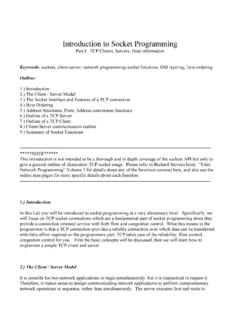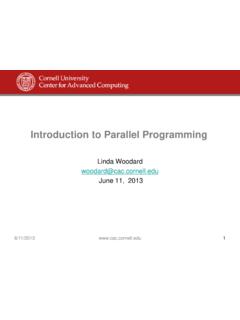Transcription of Network Programming - POCO C++ Libraries
1 Network ProgrammingWriting Network and internet > Network Programming basics>Sockets>The TCP Server Framework>The Reactor Framework>High Level Protocols: HTTP, FTP and E-MailIP Addresses>The Poco::Net::IPAddress class stores an IPv4 or IPv6 host address.>An IPAddress can be parsed from a string, or formatted to a string. Both IPv4 style ( ) and IPv6 style (x:x:x:x:x:x:x:x) notations are supported.>You can test for certain properties of an IP address: isWildcard(), isBroadcast(), isLoopback(), isMulticast(), etc.>IPAddress supports full value semantics, including all relational operators.>See the reference documentation for Addresses>A Poco::Net::SocketAddress combines an IPAddress with a port number, thus identifying the endpoint of an IP Network connection.
2 >SocketAddress supports value semantics, but not comparison.>A SocketAddress can be created from an IPAddress and a port number, a string containing an IP address and a port number, or a string containing both an IP address and a port number, separated by a Resolution>The Poco::Net::DNS class provides an interface to the Domain Name System, mapping domain names to IP addresses and vice versa.>Address information for a host is returned in the form of a Poco::Net::HostEntry object.>A HostEntry contains a host's primary name, a list of aliases, and a list of IP addresses.#include "Poco/ "#include <iostream>using Poco::Net::DNS;using Poco::Net::IPAddress;using Poco::Net::HostEntry;int main(int argc, char** argv){const HostEntry& entry = DNS::hostByName(" ");std::cout << "Canonical Name: " << () << std::endl;const HostEntry::AliasList& aliases = ();HostEntry::AliasList::const_iterator it = ()for (; it !)}
3 = (); ++it)std::cout << "Alias: " << *it << std::endl;const HostEntry::AddressList& addrs = ();HostEntry::AddressList::const_iterator it = ();for (; it != (); ++it)std::cout << "Address: " << it->toString() << std::endl;return 0;}>The socket classes in POCO are implemented using the Pimpl idiom.>POCO sockets are a very thin layer on top of BSD sockets and thus incur a minimal performance overhead basically an additional call to a (virtual) function.>A Socket object supports full value semantics (including all comparison operators).>A Socket object stores only a pointer to a corresponding SocketImpl object. SocketImpl objects are reference Socket Class>Poco::Net::Socket is the root class of the sockets inheritance tree.
4 >It supports methods that can be used with some or all kinds of sockets, like:>select() and poll()>setting and getting various socket options (timeouts, buffer sizes, reuse address flag, etc.)>getting the socket's address and the peer's addressThe StreamSocket Class>Poco::Net::StreamSocket is used for creating a TCP connection to a server.>Use sendBytes() and receiveBytes() to send and receive data, or use the Poco::Net::SocketStream class, which provides an I/O streams interface to a StreamSocket.#include "Poco/ "#include "Poco/ "#include "Poco/ "#include " "#include <iostream>int main(int argc, char** argv){Poco::Net::SocketAddress sa(" ", 80);Poco::Net::StreamSocket socket(sa)Poco::Net::SocketStream str(socket);str << "GET / \r\n" "Host: \r\n" "\r\n"; ();Poco::StreamCopier::copyStream(str, std::cout);return 0;}>Poco::Net::ServerSocket is used to create a TCP server socket.
5 >It is pretty low level.>For an actual server, consider using the TCPS erver or the Reactor ServerSocket Class#include "Poco/ "#include "Poco/ "#include "Poco/ "#include "Poco/ "int main(int argc, char** argv){Poco::Net::ServerSocket srv(8080); // does bind + listenfor (;;){Poco::Net::StreamSocket ss = ();Poco::Net::SocketStream str(ss);str << " 200 OK\r\n" "Content-Type: text/html\r\n" "\r\n" "<html> <head> <title>My 1st Web Server</title> </head>" "<body> <h1>Hello, world!</h1> </body> </html>" << std::flush;}return 0;}>Poco::Net::DatagramSocket is used to send and receive UDP packets.>Poco::Net::MulticastSocket is a subclass of Poco::Net::DatagramSocket that allows you to send multicast datagrams.
6 >To receive multicast messages, you must join a multicast group, using MulticastSocket::joinGroup().>You can specify the Network interface used for sending and receiving multicast Sockets// DatagramSocket send example#include "Poco/ "#include "Poco/ "#include " "#include " "int main(int argc, char** argv){Poco::Net::SocketAddress sa("localhost", 514);Poco::Net::DatagramSocket dgs; (sa);Poco::Timestamp now;std::string msg = Poco::DateTimeFormatter::format(now, "<14>%w %f %H:%M:%S Hello, world!"); ( (), ());return 0;}// DatagramSocket receive example#include "Poco/ "#include "Poco/ "#include <iostream>int main(int argc, char** argv){Poco::Net::SocketAddress sa(Poco::Net::IPAddress(), 514);Poco::Net::DatagramSocket dgs(sa);char buffer[1024];for (;;){Poco::Net::SocketAddress sender;int n = (buffer, sizeof(buffer)-1, sender);buffer[n] = '\0';std::cout << () << ": " << buffer << std::endl;}return 0;}// MulticastSocket receive example#include "Poco/ "#include "Poco/ "int main(int argc, char* argv[]){ Poco::Net::SocketAddress address(" ", 1900).}
7 Poco::Net::MulticastSocket socket( Poco::Net::SocketAddress( Poco::Net::IPAddress(), () ) ); // to receive any data you must join ( ()); Poco::Net::SocketAddress sender; char buffer[512]; int n = (buffer, sizeof(buffer), sender); (buffer, n, sender); return 0;}>Poco::Net::TCPS erver implements a multithreaded TCP server.>The server uses a ServerSocket to accept incoming connections. You must put the ServerSocket into listening mode before passing it to the TCPS erver.>The server maintains a queue for incoming connections.>A variable number of worker threads fetches connections from the queue to process them. The number of worker threads is adjusted automatically, depending on the number of connections waiting in the TCPS erver FrameworkThe TCPS erver Framework (cont'd)>The number of connections in the queue can be limited to prevent the server from being flooded with requests.
8 Incoming connections that no longer fit into the queue are closed immediately.>TCPS erver creates its own thread that accepts connections and places them in the queue.>TCPS erver uses TCPS erverConnection objects to handle a connection. You must create your own subclass of TCPS erverConnection, as well as a factory for it. The factory object is passed to the constructor of TCPS erver Framework (cont'd)>Your subclass of TCPS erverConnection must override the run() method. In the run() method, you handle the connection.>When run() returns, the TCPS erverConnection object will be deleted, and the connection closed.>A new TCPS erverConnection will be created for every accepted Reactor Framework>The Reactor framework is based on the Reactor design pattern, described by Douglas C.
9 Schmidt in PLOP.>Basically, it's non-blocking sockets and select() combined with a NotificationCenter.>The Poco::Net::SocketReactor observes the state of an arbitrary number of sockets, and dispatches a notification if a state of a socket changes (it becomes readable, writable, or an error occured).>Classes register a socket and a callback function with the Reactor Framework (cont'd)>The SocketReactor is used together with a SocketAcceptor.>The SocketAcceptor waits for incoming connections.>When a new connection request arrives, the SocketAcceptor accepts the connection and creates a new ServiceHandler object that handles the connection.>When the ServiceHandler is done with the connection, it must delete HTTPS erver Framework>POCO contains a ready-to-use HTTP Server framework>multithreaded>HTTP >authentication support>cookie support>HTTPS by using the NetSSL libraryHTTPS erver>configurable multi-threading>maximum number of threads>uses thread pool>queue size for pending connections>similar to TCPS erver>expects a HTTPR equestHandlerFactory>which creates HTTPR equestHandler based on the URIHTTPR equestHandlerFactory>manages all known HTTPR equestHandlers>sole purpose is to decide which request handler will answer a request>can be used to check cookies.
10 Authentication info but this is mostly done by the request handlersPoco::UInt16 port = 9999; HTTPS erverParams* pParams = new HTTPS erverParams; pParams->setMaxQueued(100); pParams->setMaxThreads(16); ServerSocket svs(port); // set-up a server socket HTTPS erver srv(new MyRequestHandlerFactory(), svs, pParams); // start the HTTPS erver (); waitForTerminationRequest(); // Stop the HTTPS erver ();#include "Poco/ "#include "Poco/ "#include " "#include " "class MyRequestHandlerFactory: publicPoco::Net::HTTPR equestHandlerFactory { public: MyRequestHandlerFactory() {} Poco::Net::HTTPR equestHandler* createRequestHandler(const Poco::Net::HTTPS erverRequest& request){if ( () == "/") return new RootHandler(); else return new DataHandler(); } };>created by the server>passed as parameter to the HTTPR equestHandler/-Factory>contains URI>cookies>authentification information>HTML form dataHTTPS erverRequestHTTPS erverResponse>created by the server but initialized by the request handler>set cookies >set content type of the ("text/html").








